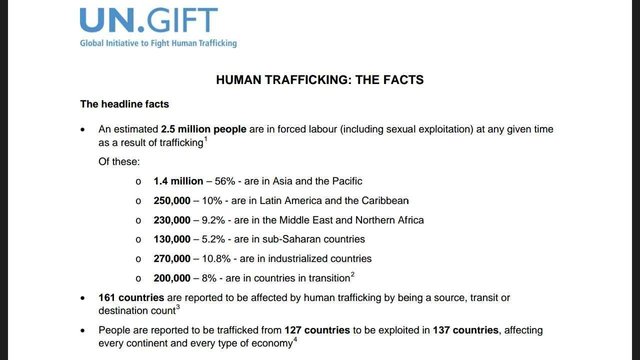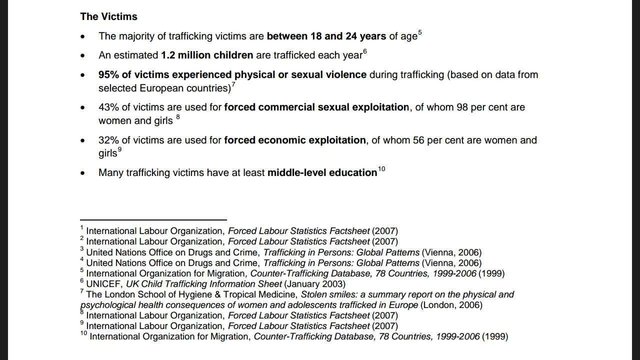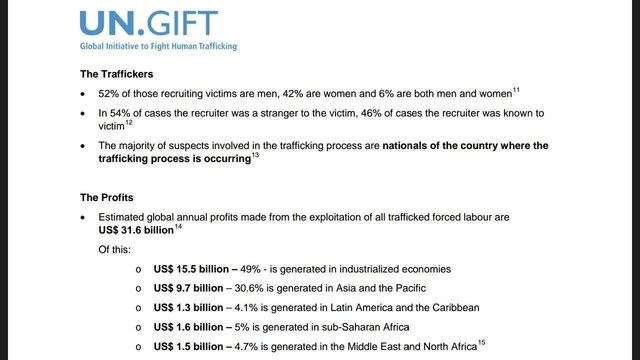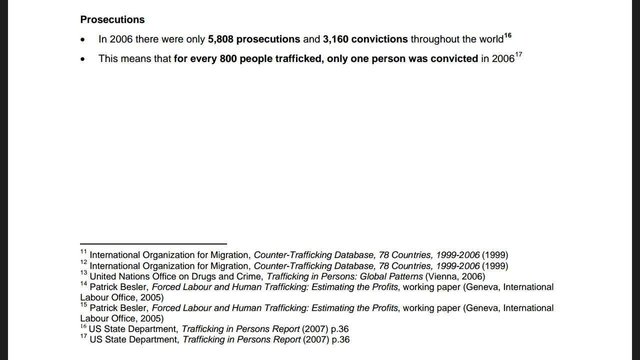



HUMAN TRAFFICKING: THE FACTS
The headline facts
• An estimated 2.5 million people are in forced labour (including sexual exploitation) at any given time
as a result of trafficking1
Of these:
o 1.4 million – 56% - are in Asia and the Pacific
o 250,000 – 10% - are in Latin America and the Caribbean
o 230,000 – 9.2% - are in the Middle East and Northern Africa
o 130,000 – 5.2% - are in sub-Saharan countries
o 270,000 – 10.8% - are in industrialized countries
o 200,000 – 8% - are in countries in transition2
• 161 countries are reported to be affected by human trafficking by being a source, transit or
destination count3
• People are reported to be trafficked from 127 countries to be exploited in 137 countries, affecting
every continent and every type of economy4
The Victims
• The majority of trafficking victims are between 18 and 24 years of age5
• An estimated 1.2 million children are trafficked each year6
• 95% of victims experienced physical or sexual violence during trafficking (based on data from
selected European countries)7
• 43% of victims are used for forced commercial sexual exploitation, of whom 98 per cent are
women and girls 8
• 32% of victims are used for forced economic exploitation, of whom 56 per cent are women and
girls9
• Many trafficking victims have at least middle-level education10
1
International Labour Organization, Forced Labour Statistics Factsheet (2007) 2
International Labour Organization, Forced Labour Statistics Factsheet (2007) 3
United Nations Office on Drugs and Crime, Trafficking in Persons: Global Patterns (Vienna, 2006) 4
United Nations Office on Drugs and Crime, Trafficking in Persons: Global Patterns (Vienna, 2006) 5
International Organization for Migration, Counter-Trafficking Database, 78 Countries, 1999-2006 (1999) 6
UNICEF, UK Child Trafficking Information Sheet (January 2003) 7
The London School of Hygiene & Tropical Medicine, Stolen smiles: a summary report on the physical and
psychological health consequences of women and adolescents trafficked in Europe (London, 2006) 8
International Labour Organization, Forced Labour ###Statistics Factsheet (2007) 9
International Labour Organization, Forced Labour Statistics Factsheet (2007) 10 International Organization for Migration, Counter-Trafficking Database, 78 Countries, 1999-2006 (1999)
The Traffickers
• 52% of those recruiting victims are men, 42% are women and 6% are both men and women11
• In 54% of cases the recruiter was a stranger to the victim, 46% of cases the recruiter was known to
victim12
• The majority of suspects involved in the trafficking process are nationals of the country where the trafficking process is occurring13
The Profits
• Estimated global annual profits made from the exploitation of all trafficked forced labour are
US$ 31.6 billion14
Of this:
o US$ 15.5 billion – 49% - is generated in industrialized economies
o US$ 9.7 billion – 30.6% is generated in Asia and the Pacific
o US$ 1.3 billion – 4.1% is generated in Latin America and the Caribbean
o US$ 1.6 billion – 5% is generated in sub-Saharan Africa
o US$ 1.5 billion – 4.7% is generated in the Middle East and North Africa15
Prosecutions
• In 2006 there were only 5,808 prosecutions and 3,160 convictions throughout the world16
• This means that for every 800 people trafficked, only one person was convicted in 200617
11 International Organization for Migration, Counter-Trafficking Database, 78 Countries, 1999-2006 (1999) 12 International Organization for Migration, Counter-Trafficking Database, 78 Countries, 1999-2006 (1999) 13 United Nations Office on Drugs and Crime, Trafficking in Persons: Global Patterns (Vienna, 2006) 14 Patrick Besler, Forced Labour and Human Trafficking: Estimating the Profits, working paper (Geneva, International
Labour Office, 2005)
15 Patrick Besler, Forced Labour and Human Trafficking: Estimating the Profits, working paper (Geneva, International
Labour Office, 2005)
16 US State Department, Trafficking in Persons Report (2007) p.36 17 US State Department, Trafficking in Persons Report (2007) p.36
CSZ HQ
Who is watching the watchers? The US State Department and the United Nations have been implicated in child trafficking so:
1l Why should we believe these reports?
- Does that explain the low level of convictions?
- Are the low level patsies getting arrested while the top level players remain immune from prosecution?
- How can We the People combat this?
Your comments welcome below.
CSZ HQ